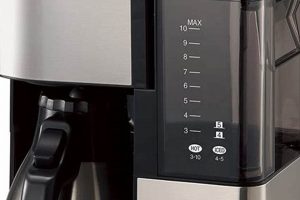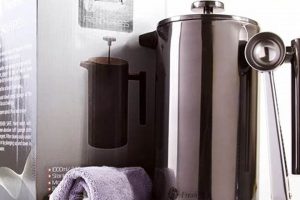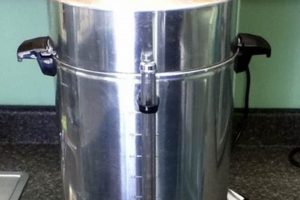Addressing operational issues in commercial beverage brewing equipment is a vital aspect of maintaining efficient service and preventing disruptions. When problems arise with these systems, a systematic approach to problem-solving can identify the root cause and enable a swift resolution. This approach generally involves examining symptoms, verifying connections, and testing components to isolate the source of the malfunction.
Efficient equipment troubleshooting minimizes downtime, reduces potential revenue loss, and extends the lifespan of the brewing apparatus. Early identification of minor issues can prevent them from escalating into more complex and costly repairs. Furthermore, understanding the equipment’s operational principles allows for proactive maintenance and preventative measures, enhancing long-term performance.
The following sections will provide a structured guide to addressing common problems encountered with commercial coffee brewing systems, outlining diagnostic procedures and offering potential solutions to restore optimal operation. These will cover areas like heating issues, flow issues and electronic control concerns.
Troubleshooting Strategies for Commercial Coffee Brewing Systems
This section provides practical guidance for diagnosing and resolving common issues encountered with commercial coffee brewing equipment. A methodical approach, focusing on identifying the symptoms and systematically eliminating potential causes, is crucial for effective resolution.
Tip 1: Verify Power Supply and Connections: Begin by confirming that the unit is receiving power. Check the power cord for damage and ensure it is securely plugged into a functioning outlet. Examine all electrical connections within the unit for looseness or corrosion.
Tip 2: Inspect Water Supply and Flow: Ensure the water supply is connected and turned on. Check for kinks or obstructions in the water lines. Verify that the water inlet valve is functioning correctly and allowing water to flow into the brewing system.
Tip 3: Examine Heating Element Function: If the system fails to heat, test the heating element using a multimeter to confirm continuity. Inspect the element for signs of physical damage or burnout. If a temperature sensor is present, verify its functionality with appropriate testing equipment.
Tip 4: Check Float Switches and Level Sensors: These components are critical for maintaining proper water levels. Ensure they are clean, free from obstructions, and functioning correctly. Malfunctioning float switches or level sensors can lead to overfilling or a failure to brew.
Tip 5: Examine Control Board and Electronics: Inspect the control board for signs of damage, such as burned components or loose connections. If equipped with a digital display, check for error codes that can provide clues to the nature of the problem.
Tip 6: Verify Spray Head or Dispersion System: Ensure the spray head is clean and unobstructed. Mineral deposits or coffee grounds can clog the spray head, resulting in uneven coffee extraction. Disassemble and clean the spray head as needed.
Tip 7: Observe Brewing Cycle and Output: Carefully observe the brewing cycle for any unusual sounds, smells, or leaks. Monitor the quality and quantity of the brewed coffee. Changes in these parameters can indicate a variety of underlying problems.
Effective troubleshooting necessitates a systematic, step-by-step process. Starting with basic checks and progressing to more complex diagnostics increases the likelihood of identifying the root cause of the malfunction. Regular maintenance and cleaning further support reliable operation.
Subsequent sections will elaborate on specific troubleshooting scenarios and offer advanced techniques for addressing complex issues with commercial coffee brewing equipment.
1. Power Supply Verification
Power supply verification forms the crucial initial step in addressing malfunctions in commercial coffee brewing equipment. Inadequate or fluctuating power can manifest in a variety of operational problems, including failure to heat, inconsistent brewing cycles, and erratic display behavior. Prioritizing power supply checks establishes a baseline for subsequent diagnostic procedures. For example, a machine displaying a blank control panel or exhibiting intermittent operation often points directly to a power supply issue. This initial step eliminates the power source as a contributing factor, thereby streamlining the troubleshooting process.
Several methods facilitate power supply verification. A visual inspection of the power cord for damage is paramount. Subsequently, confirming the outlet’s functionality using a separate device ensures the source is providing power. Employing a multimeter to measure the voltage at the unit’s power input provides definitive data regarding the stability and adequacy of the voltage. A deviation from the specified voltage range, often printed near the power input, indicates a problem requiring immediate attention. Resolving power delivery issues often precedes further investigation into internal components.
Failure to rigorously verify power supply can lead to misdiagnosis and unnecessary replacement of internal components. A systematic power supply check, therefore, constitutes an indispensable practice. This foundational step ensures that subsequent diagnostic efforts are targeted towards the actual source of the brewing equipment’s malfunction, facilitating efficient and cost-effective repairs. A stable power source is the bedrock upon which all other functions depend.
2. Water Flow Assessment
In commercial coffee brewing systems, consistent and controlled water flow is paramount for optimal extraction and beverage quality. A systematic evaluation of water flow constitutes a critical step in diagnosing and rectifying malfunctions, impacting brew volume, strength, and overall machine performance. Deficient or erratic water flow often points to specific underlying issues within the brewing system.
- Identifying Blockages
Mineral scale buildup, sediment accumulation, and obstructions within water lines are primary causes of restricted flow. Identifying such blockages involves visual inspection of hoses and connectors, as well as disassembly and cleaning of components like inlet valves and spray heads. Reduced flow leads to under-extraction and weak coffee.
- Evaluating Pump Function
Many commercial brewers utilize pumps to maintain consistent water pressure. Assessing pump performance includes verifying proper voltage supply, listening for unusual noises indicative of cavitation or wear, and measuring flow rate at the outlet. A failing pump results in inconsistent brew volumes and prolonged brewing times.
- Examining Valve Operation
Solenoid valves control the flow of water at various stages of the brewing cycle. Testing valve functionality involves verifying proper actuation upon receiving a signal from the control board and inspecting the valve seat for leaks or damage. Malfunctioning valves can cause overfilling, underfilling, or a complete cessation of brewing.
- Analyzing Flow Meter Accuracy
Flow meters, if present, precisely measure the volume of water dispensed during each brewing cycle. Verifying the accuracy of the flow meter ensures consistent brew volumes and proper coffee-to-water ratios. Deviations in flow meter readings indicate a potential calibration issue or sensor malfunction, leading to inconsistent coffee strength.
By systematically evaluating these facets of water flow, potential problems within the brewing apparatus can be effectively identified. Addressing water flow issues resolves many operational problems, restoring optimal brewing performance. Diligent flow assessment, therefore, plays a crucial role in maintaining consistent coffee quality and maximizing equipment lifespan.
3. Heating Element Inspection
Verification of heating element functionality is a pivotal step in effectively addressing operational issues in commercial coffee brewing equipment. A malfunctioning heating element directly impacts the brewing process, resulting in cold or lukewarm coffee, and ultimately rendering the machine unusable. Therefore, a systematic examination is paramount for accurate diagnosis and swift restoration of service.
- Continuity Testing
The first step in inspecting a heating element is to perform a continuity test using a multimeter. This test verifies whether the element is electrically intact and capable of completing a circuit. A reading of infinite resistance indicates a broken element requiring replacement. For example, a failed continuity test on a 220V heating element would immediately point to its failure to generate heat, halting the brewing cycle. Such a test, when part of the overall procedure, can quickly pinpoint why a coffee brewer is not heating.
- Visual Examination for Damage
A thorough visual examination of the heating element can reveal signs of physical damage, such as burns, cracks, or corrosion. These visual indicators often correlate with electrical malfunctions and provide valuable insights into the cause of failure. For instance, visible charring on the element’s surface suggests overheating, potentially due to scale buildup or inadequate water flow. Detecting such damage informs the necessity for replacement and addresses underlying causes.
- Resistance Measurement and Comparison
Measuring the resistance of the heating element and comparing it to the manufacturer’s specifications is crucial. A significant deviation from the expected resistance value indicates a degradation of the element’s performance, even if continuity is present. Consider a heating element rated for 20 ohms exhibiting a measured resistance of 30 ohms. Such variance suggests an impending failure and decreased heating efficiency, influencing brewing time and water temperature accuracy.
- Ground Fault Testing
A ground fault test checks for any electrical leakage from the heating element to the metal chassis of the coffee brewer. This condition presents a safety hazard and can cause the unit to trip circuit breakers. Using a multimeter to measure the resistance between the heating element terminals and the chassis will identify a ground fault. High resistance should be indicated. Ground fault testing during troubleshooting safeguards against electrical shock and identifies potential safety concerns.
Proper “heating element inspection” involves these steps. It is important to accurately diagnose the root cause of brewing equipment malfunction. This careful approach improves the effectiveness of repairs and reduces equipment downtime. Early detection of heating element issues prevents escalated problems. It also ensures the consistent delivery of quality coffee.
4. Sensor Functionality Check
Sensor functionality is integral to the reliable operation of commercial coffee brewing equipment. Therefore, sensor functionality evaluation represents a crucial phase in the troubleshooting process. Malfunctioning sensors can yield inaccurate data regarding water levels, temperature readings, and brewing cycle progression, resulting in various operational errors. Disruption to operation examples of which include overfilling, inadequate heating, or premature cycle termination. This makes systematic verification indispensable for proper equipment operation. Consider a scenario where a temperature sensor provides an incorrect reading. The brewing system may fail to reach the optimal brewing temperature. This results in under-extracted coffee with poor taste characteristics. Accurate sensor operation is vital.
The diagnostic process generally includes assessment using a multimeter. It can also involve visual inspection for damage or corrosion. Comparison of sensor output against expected values is also helpful. For example, thermocouples and RTDs (Resistance Temperature Detectors), commonly employed for temperature sensing, can be evaluated by comparing measured resistance values against known temperature-resistance curves. Similarly, float sensors, pivotal for water level monitoring, are checked for free movement and proper electrical switching at specified levels. Flow sensors are assessed by measuring volume dispensed. These measurements can then be compared to programmed settings. Replacing defective components ensures the system relies on accurate data for its operation.
Ultimately, incorporating sensor functionality checks into the troubleshooting methodology provides a robust approach to equipment maintenance. Addressing sensor-related issues prevents recurring problems. It also minimizes downtime. It ensures the coffee brewing system operates within specified parameters. Consistent sensor evaluation contributes to consistent product quality and extends equipment lifespan. Furthermore, periodic assessments can catch minor deviations before they escalate. Early assessment prevents more significant failures. Therefore, regular assessments are cost-effective. These also increase the long-term reliability of commercial coffee brewing systems.
5. Control Board Diagnostics
The control board serves as the central processing unit in automated commercial coffee brewing systems, coordinating all operational functions based on sensor inputs and programmed parameters. Therefore, effective troubleshooting inherently necessitates a comprehensive evaluation of the control board’s performance. Malfunctions within the control board can manifest in a wide array of symptoms, ranging from complete system failure to erratic brewing cycles. Addressing operational failures, requires a systematic approach to determine the root cause and implement corrective measures.
Addressing this, Control board diagnostics constitutes a critical subset of troubleshooting commercial coffee brewing equipment. For example, a failure to initiate the brewing cycle might stem from a faulty relay on the control board. Likewise, inconsistent water temperatures could result from a malfunctioning temperature sensor input on the board. Error codes displayed on the control panel often provide valuable clues. These clues can help pinpoint the source of the problem. However, interpreting these codes requires knowledge of the specific equipment’s diagnostic protocols. A multimeter assists in verifying voltage levels and signal integrity at various points on the control board. Logical assessment ensures that the replacement of components is justified. This is particularly important due to the electronic sensitivity of components.
Neglecting control board diagnostics during the troubleshooting process can lead to misdiagnosis and unnecessary component replacements, increasing repair costs and downtime. The integration of methodical control board assessment ensures efficient identification of issues. This further facilitates targeted and effective repairs. Understanding the interdependence between control board functionality and overall brewing system performance enhances the efficacy of troubleshooting efforts. This will also promote long-term equipment reliability and optimal beverage quality.
6. Component Physical Examination
Physical examination of components is a crucial element in diagnosing malfunctions within commercial coffee brewing equipment. This process involves a thorough visual and tactile inspection of the system’s constituent parts to identify signs of damage, wear, or degradation that may be contributing to operational issues. It serves as a complementary step to electrical and functional testing, often revealing problems that may not be immediately apparent through other diagnostic methods.
- Leak Detection and Assessment
Examining components for leaks is paramount, as water ingress can lead to electrical shorts, corrosion, and compromised structural integrity. Leaks around seals, connections, and tanks indicate potential wear or failure of these components. For example, a visible water trail originating from a cracked water tank immediately points to the tank as the source of the problem, necessitating replacement. Identifying and addressing leaks prevents further damage to sensitive electronic components and ensures safe operation.
- Inspection for Corrosion and Scale Buildup
Corrosion and scale buildup are common issues in coffee brewing equipment, especially in regions with hard water. Visual examination of heating elements, water lines, and sensors can reveal the extent of corrosion and scale accumulation, which can impede heat transfer, restrict water flow, and ultimately lead to component failure. For instance, a heavily scaled heating element may fail to heat water effectively, resulting in weak or cold coffee. Addressing corrosion and scale buildup through cleaning or component replacement restores optimal performance.
- Assessment of Mechanical Wear and Tear
Components such as pumps, valves, and moving parts are subject to mechanical wear and tear over time. Physical inspection can reveal signs of wear, such as cracked impellers in pumps, worn valve seats, or loose connections. For example, a pump exhibiting excessive vibration or unusual noise may have a worn impeller requiring replacement. Early identification of mechanical wear allows for proactive maintenance, preventing catastrophic failures and extending equipment lifespan.
- Verification of Proper Assembly and Connections
Physical examination also involves verifying that all components are correctly assembled and securely connected. Loose connections, improperly installed seals, or misaligned parts can lead to leaks, electrical shorts, and mechanical malfunctions. For example, a loose electrical connection on a heating element can cause intermittent heating or even a complete failure of the element. Ensuring proper assembly and connections minimizes the risk of operational problems and promotes safe and reliable operation.
By integrating component physical examination into the overall troubleshooting process, technicians can gain a more complete understanding of the causes of malfunctions. This holistic approach, combining visual, tactile, and electrical assessments, leads to more accurate diagnoses, effective repairs, and enhanced long-term performance of commercial coffee brewing equipment. Such a complete approach reduces the need for recurring repairs.
Frequently Asked Questions
The following addresses common inquiries related to maintaining and resolving issues with commercial coffee brewing systems. These points aim to clarify operation procedures and aid in resolving technical difficulties.
Question 1: What initial steps should be taken when encountering an operational failure?
Begin by verifying the power supply and water source are functioning correctly. Inspect the equipment for any obvious physical damage or leaks.
Question 2: How often should routine maintenance be performed on commercial coffee brewing equipment?
Routine maintenance, including cleaning and descaling, should be performed at intervals specified by the manufacturer, typically ranging from weekly to monthly, depending on usage.
Question 3: What are common indicators of a failing heating element?
Indicators include the inability to reach brewing temperature, prolonged heating times, and the presence of error codes related to temperature sensing.
Question 4: How can mineral scale buildup be effectively addressed within the system?
Descaling solutions formulated for coffee brewing equipment should be used according to the manufacturer’s instructions. Regular descaling intervals mitigate scale accumulation.
Question 5: What is the significance of error codes displayed on the control panel?
Error codes provide diagnostic information related to specific malfunctions within the system, facilitating targeted troubleshooting and repair efforts.
Question 6: When is it advisable to consult a qualified technician for repairs?
Complex malfunctions, electrical issues, or situations involving specialized tools and expertise warrant consultation with a qualified technician.
Addressing operational problems effectively requires attention to detail and a systematic approach. Proper care and maintenance extend equipment lifespan and ensure consistent beverage quality.
The subsequent section will address advanced troubleshooting scenarios and provide guidance on complex system diagnostics.
Conclusion
This discussion has provided a structured methodology for addressing malfunctions in commercial brewing equipment. The outlined steps, encompassing power verification, flow assessment, heating element inspection, sensor checks, control board diagnostics, and physical examination, constitute a systematic approach to problem resolution. Effective application of these principles contributes to the swift identification and correction of operational anomalies.
Employing a diligent, methodical process in how to troubleshoot curtis coffee maker, is crucial for reducing downtime, minimizing repair expenses, and ensuring the consistent delivery of high-quality brewed beverages. Continued adherence to these troubleshooting techniques will promote equipment longevity and operational efficiency.







![The Best Turquoise Coffee Maker: [Brand Name] & More! Safem Fabrication - Precision Engineering & Custom Manufacturing Solutions The Best Turquoise Coffee Maker: [Brand Name] & More! | Safem Fabrication - Precision Engineering & Custom Manufacturing Solutions](https://deacoffee.com/wp-content/uploads/2025/06/th-1651-300x200.jpg)